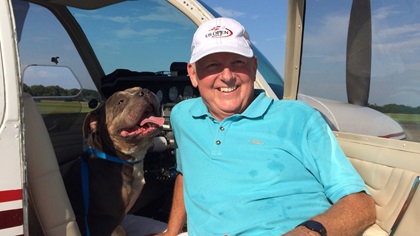Flights from trouble
GA pilots help rescued animals start new lives
Typical summer VFR weather prevailed along the Gulf Coast as Paul McGhee flew his 1956 Beechcraft Bonanza from St. Landry Parish-Ahart Field Airport in Opelousas, Louisiana, to Southwest Florida International Airport in Fort Myers, dodging buildups and hugging the shoreline rather than heading directly across open water to the destination.
By no means typical was McGhee’s passenger manifest on the muggy August afternoon: Three puppies occupied a crate in the back of the aircraft. Two pairs of young Labrador retrievers also rode in back, as did another pair of small dogs.
McGhee, 62, a software engineer and instrument-rated pilot who lives in an airport community in Spruce Creek, Florida, landed in Fort Myers after a four-and-a-half-hour flight, and turned his charges over to Theresa Ink’s Paws of Lee County, thus completing his first mission as a volunteer pilot for Pilots N Paws, a nonprofit that helps animals in need of rescue, shelter, or adoption by matching up volunteer pilots with cases in which transporting an animal will provide a solution.
Such a need soared after late August rainfall in the Gulf region produced severe flooding, especially in Louisiana, where Pilots N Paws facilitated six rescue flights involving a total of about 50 animals, said Executive Director Kate Quinn.
McGhee, a 12-year pilot who owned a Cirrus SR22 before recently acquiring the Bonanza, isn’t a pet owner. A link sent to him on Facebook by a friend brought Pilots N Paws to his attention, and then a direct email appeal from Quinn got him thinking about pitching in.
With a weekend free, an opportunity to fly coming, and the need plainly evident, “I tried to do something nice for someone,” he said.
McGhee flew to New Orleans and spent a day there. He awoke the next morning and flew to Opelousas to pick up Cleetis—the name someone had given the pit bull—and the other dogs.
The mission was gratifying, especially because McGhee understood that being a pilot gave him a special way to help other people help the animals.
“The people I was thinking about were all these volunteers who did all these things for animals and everybody else,” he said. “It was so important for them. I feel like I was doing it for them,” he said in a phone interview.

Things get complicated in the animal rescue field when a natural disaster strikes. Quinn explains that some of the animals transported from Louisiana after the flooding were already in shelters before the rains came, and were being taken in elsewhere to make room locally for newly rescued animals who might still be reunited with their owners.
The animals flown to Florida by McGhee were in more difficult straits. All had just been saved from an uncertain fate by Stacey Alleman, a shelter operator in St. Landry Parish who went to flooded areas and freed animals trapped as the waters rose—including one dog she found still “attached to a fence,” McGhee had learned.
“These were true strays that she rescued just off the roads,” he said.
McGhee’s transformation to a rescue pilot is an encouragement to Quinn, whose outreach to the aviation community is fueled by knowing that many general aviation pilots—pet owners or not—recognize their special capability to make a contribution through public-benefit flying.
That desire to serve the public continued as volunteer pilots answered the call when Hurricane Hermine made landfall in Florida on Sept. 2, the first hurricane to come ashore in Florida since 2005. In response, the Civil Air Patrol’s Florida Wing overflew stricken areas to capture more than 1,300 digital images, prompting CAP photographer Major Richard Morrell to note in a news release, “I was impressed by how much technology we were using in the small airplane.”
Not surprisingly, given the urge to serve among pilots, Pilots N Paws is frequently contacted by aviators who have learned of the organization’s existence and want to know how they can become involved. Quinn adds that for some student pilots, helping rescue animals is a motivation to learn to fly.
She points out, as did McGhee, that the work benefits not just the animals, but for the people who care about them. Many pet adopters write to Pilots N Paws to express their gratitude to the pilots for bringing an animal into their lives. “Some are dealing with depression, or cancer, or maybe they just lost their job. One dog saved its family from a fire. It’s amazing how you are really helping people in addition to saving animals,” she said.
In 2013 Pilots N Paws was the recipient of a Giving Back grant from the AOPA Foundation, to fund two of the organization’s annual “fly-away” events. Pilots N Paws’ outreach includes attending aviation events such as the AOPA Fly-ins, where response has been strong.
As for Cleetis, McGhee was pleased to report that the big but battered pit bull has been adopted by a shelter worker in Fort Myers, is making a nice recovery, and has had his name changed—appropriately, considering what he has been through—to Chaos.
Like many rescue pilots, McGhee hopes to keep in touch with his former passenger through the dog’s new caretaker, who is working to help the animal heal from numerous injuries.
“I asked her to send me a picture,” McGhee said.




